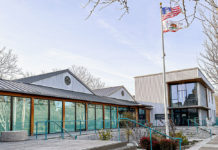Residents of the Windsor Creek subdivision brought the Windsor
Town Council to a standstill last week, mounting a well-organized
attack on the developer’s most recent plan for completing the
project.
Forty-five homes have been built during the past five years in
the first phase of the subdivision, which is south of the old
downtown. Based on a 1998 map approved by the council, the
developer, MLB Homes of Sebastopol, has the right to build 19 more
homes in the project’s second phase, but the project faces several
challenges.
In 1999 the town’s engineering department raised the possibility
that several of the lots in the second phase could be subject to
flooding. The result, according to MLB Homes president Michael
Bianucci, was a two-year effort to reconfigure the project taking
into account the new hydrology information.
Bianucci eventually proposed that the troublesome lots near the
creek remain open space, being replaced by five lots created from
open space on Beverly Lane, across the street from several existing
homes in the subdivision’s first phase. But at the Oct. 15 council
meeting it became apparent that neighbors near Beverly Lane did not
like the idea.
An agreement between MLB and the town on two other issues
created further complexity. In July, the town and MLB had agreed to
an arrangement whereby the town would take over responsibility for
maintaining small parcels of open space within the subdivision – a
previous sticking point – and MLB would construct a hiking and
bicycle path along East Windsor Creek, under a nearby railroad
trestle. The trail was to connect the subdivision with trails on
the waste water treatment facility’s land, making possible a
contiguous trail system clear to downtown.
But the California Department of Fish and Game raised concerns
over fish habitat, and the trail idea had to be nixed, leaving that
agreement between MLB and the town in doubt.
Bianucci has subsequently offered to set up a $40,000 endowment
for maintenance of the open spaces in the subdivision, but the town
contends that’s not enough to do the job.
Last Wednesday, neighbors mounted an organized attack on MLB’s
plan to build on Beverly Lane, sending a stream of speakers to the
podium.
The neighbors did not all agree with one another. Jerry Minton
of Emsos Way simply lobbied for quick completion of the project to
minimize problems of transients and garbage in undeveloped areas.
Felix Woidtke, who lives at the as-yet-unpaved end of Old Oak Road
said, “I just wish the whole thing would get finished.”
But Michael Girkout of Old Oak Road argued against building on
Beverly Lane. “Original homeowners should not have to pay for
others’ mistakes,” insisted Girkout.
Karen Roberts of Old Oak Road told the council, “It seems to me
that whoever has the most money usually wins.” And John Walker of
Old Oak Road proclaimed himself “vehemently opposed” to putting the
five houses on Beverly Lane.
When councilmembers spoke it was obvious that the neighbors had
had an impact.
“If I could have my way I’d like to take those five parcels out
of the plan and keep the rest of the (1998) map as you see it,”
said Mayor Pro Tem Debora Fudge.
“The old (1998) plan is not the best plan,” said Councilmember
Sam Salmon. “We might have to give up the ($40,000) endowment for
those five houses.” Salmon also noted that, “While the developer is
allowed to build 19 homes, it doesn’t mean he has to build 19
homes.”
Councilmember Steve Allen said that, out of consideration for
neighbors who were told the Beverly Lane parcel would remain open,
he did not think homes should be built there. But “I don’t know
that the $40,000 is enough to make those five homes go away,” Allen
said.
Allen suggested approaching the Sonoma County Agricultural
Preservation and Open Spaces District about purchasing the open
space.
Fudge suggested the possibility of creating smaller lots, or
more duplexes to recover the five sites.
Bianucci responded that such revisions would have to go through
too much government bureaucracy to be approved. “Any revision you
do is going to be a monumental effort that we’re not going to be up
for,” he said. He also noted that shrinking lots or building more
duplexes was not good for business. “I am in this business to make
a profit,” he noted.
Bianucci argued for a speedy resolution to the impasse. “There’s
always the possibility of the city purchasing the property and
doing whatever they want,” he said.
Eventually Salmon moved to continue the subject to a future
council meeting. Bianucci restated his need for a quick resolution
of the issue. “Waiting until after the first of the year is too
long,” he said.
“This is one of the most challenging sites for development in
the town,” noted Town of Windsor Planning Director Peter Chamberlin
in a later conversation. “Everywhere you go there’s a problem.”
Bianucci said in a subsequent phone conversation that he expects
now to go back to the 1998 map and build all 19 homes as originally
planned. He cited the opinion of Paul Wade of the town’s
engineering department who suggested, at the council meeting, that
upstream improvements have largely solved the flood control issue
at Windsor Creek.
Chamberlin noted that existing agreements still require
downstream flood control work before phase two of the project can
be approved.
If the council takes that approach, Bianucci said, he may be
forced to take further action. He declined to state specifically
what the action might be.
50.7
F
Healdsburg
April 19, 2025







